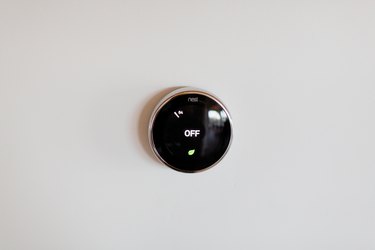If you're going to pay beaucoup bucks each month for your heating and air conditioning, you may as well get the comfort for which you're supposedly paying, and living with one floor comfy and the other freezing or boiling is ideal only if all that sweater-changing is prepping you for a career as a quick-change artist. Balancing your upstairs and downstairs airflow and temperatures can be either DIY or certified-tech territory. Whichever it is, do yourself and your pocketbook a favor: Take care of it ... and pack away that cardigan.
First, Check These Items
Video of the Day
There are a few basics you can check yourself if only certain rooms aren't heating or cooling. Replace a dirty filter. Check for closed vents or vents blocked by furniture. Make sure you don't have loose connections where your ducts meet your vents. If your house is older and has rooms with uninsulated exterior walls, call your insulating contractor.
Video of the Day
When DIY measures make no difference, it's time to get serious. You'll save energy and — in the long run — money by calling a certified air-balancing technician or someone with knowledge about adjusting or creating a zoned HVAC system.
Address Airflow Delivery
When you can't balance your home temperature, especially when there's an obvious and unacceptable difference between your upstairs and downstairs temperatures, and your basic DIY checking of filters, vents, insulation and ductwork doesn't help, it's pretty much a given that you have a problem with airflow. You'll need a certified air-balancing technician, which can be expensive depending on how many ducts you have and whether your system was correctly installed, but a poorly functioning system is already costing you money, and utilizing a trained specialist means it will probably never need adjusting again.
In air balancing, your tech will test and measure such things as air pressure, temperature and airflow at supply vents. This will help to determine needed adjustments, usually through manipulation of dampers, that will result in the right amount of air being delivered to each room and area. Your system can't run effectively when there's an airflow imbalance. You'll lose energy savings and live uncomfortably.
Consider a Zoned System
The difference between air balancing and zoning is that one addresses your system's airflow, and the other allows precise temperature control throughout your home. If you're in the market for a new HVAC system, opting for a high-efficiency programmable zoned system can solve your upstairs/downstairs temperature dilemma. Employing motorized dampers and area- or room-dedicated thermostats, these systems give you total control over which spots in your house are heated or cooled and when. Unlike a standard HVAC system that sends the same amount of heated or cooled air everywhere each time it kicks on, a zoned system lets you decide which areas to target.
A standard HVAC system can be converted to programmed zoning by adding a control panel, motorized dampers and thermostats for each room but again, let a pro handle this to ensure that you wind up with an efficient product. Zoning can also be created with an older standard system simply by manually adjusting preexisting dampers. It's wise to get help from a certified HVAC pro when determining effective damper positioning.
If you already have a programmed HVAC zoning system and still have temperature differentials on the upper and lower floors, you should have a technician look into whether the system was installed according to plans and then make adjustments accordingly.
Be Sure to Check Credentials
A contractor with little knowledge about air balancing and zoning can leave you with more problems than you had before calling, so always shoot for trained and certified. If, like some people, you're hesitant to ask for credentials, check the company's ads or website. Look for designations and certifications from such organizations as the National Comfort Institute, North American Technician Excellence and especially the Associated Air Balance Council. If you see nothing, buck up and ask. It's all about your comfort and your pocketbook, and you have the right to know.
- Tuckey: Ask Our Experts: Balancing an HVAC System
- PickHvac Cooling & Heating Guide: Do I Need a Zoned HVAC System? Pros, Cons and Cost of HVAC Zoning System
- Contracting Business: Air Balancing a System With Zoning
- Associated Air Balance Council: Test & Balance Certification
- National Comfort Institute, Inc.: Residential Air Balancing Certification
- North American Technician Excellence: Certified HVAC Professional
